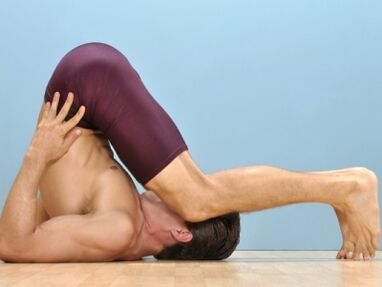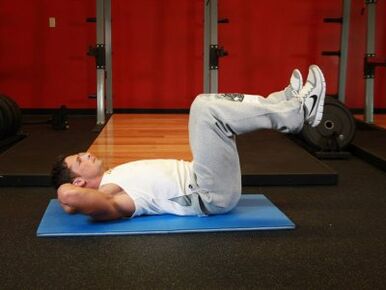
Prostatitis and benign prostatic hyperplasia is a fairly common disease in the elderly male population.
The main symptom of prostate adenoma is difficulty urinating due to compression of the urethra.
With these diseases, in the context of complex therapy, along with drugs, folk remedies, for example, the use of dead bees for prostate adenoma and surgical methods, as well as to prevent congestion and inflammation, therapeutic exercises are recommended.
Special exercises for prostatitis and prostate adenoma should be performed for a fairly long period of time. They aim at strengthening the muscles of the pelvis, perineum, lower extremities, in the general strengthening of the body.
Also, recommended exercises for prostatitis and prostate adenoma occur in a man after surgery on the prostate gland to avoid complications. In this case, they should be performed gently and taking into account the well-being of the patient.
Physiotherapy for prostate adenoma: the main complexes of physical exercises

Physiotherapy for prostate adenoma, as well as massage, improves blood circulation to the pelvic organs.
This can stop the development of the pathological process, reduce the growth rate of a benign tumor.
Exercise for prostate adenoma includes static and dynamic exercises.
General strengthening exercises, such as walking, running, cycling, are reported as dynamic. It is also worth doing exercises such as squatting, walking on the buttocks, rolling with the ball, exercises with lifting and lifting the legs or lifting the pelvis lying down.
Static exercises include standing positions with prolonged tension of a specific muscle group.
It is useful to note
Strengthening the muscles of the back and abdomen is essential. For this, the exercises are performed lying down, on the side, on the stomach, twisting and push-ups. One of the most effective exercises is a supine bicycle to complicate the exercise - with a raised pelvis.
All kinds of lifts and inclines, rotational movements of the pelvis are useful. There are special sets of exercises that target the perineal muscle group.
The most famous and effective set of exercises for prostate adenoma is the Kegel complex, created by a gynecologist for women and modified for men. Its main exercises are performed standing and lying down, consisting of training the muscles of the anus and perineum, with the aim of preventing congestion in the perineum and small pelvis.
The band should be performed in the morning, after hygiene procedures and in the evening. Bedtime exercises with prostate adenoma are recommended to be done 2-3 hours before bedtime.
Note
Exercise for prostate adenoma should be performed taking into account the well-being of the patient, should not be strained and imposed progress, the complexity of the exercises must necessarily take into account the age of the patient and agree with the treating physician.
A well-chosen set of exercises after prostate surgery can help significantly during the postoperative recovery period. Exercise should be regular.
The whole set of exercises does not require much time, but its regular use has a good effect on the general condition of the man's body and on the blood circulation in the pelvic organs, reduces the severity of congestion and edema.
Also, strengthening the muscles of the abdomen and perineum has a positive effect on the process of urination and in the future will be an excellent prevention of prostate adenoma.
Great
It is also necessary to remember about the measure in performing the exercises, they should bring pleasure and slight fatigue, but they should not be accompanied by painful sensations or be done with force.
Therapeutic exercise for prostate adenoma

Recommended exercise for prostate adenoma is not only performed for benign prostatic hyperplasia, but may also be helpful for those patients who have undergone prostate cancer surgery in chronic prostatitis.
Physical therapy in combination with medication can help reduce swelling and congestion in the small pelvis and, consequently, reduce urethral obstruction and improve urine production. Therapeutic exercise for prostate adenoma, or exercise therapy, is performed under the supervision of a specialist, in groups, often in medical institutions, and consists of three stages.
In the first stage a general physical activity is given that includes aerobic exercise, running, jumping and warming up.
In the second stage, special exercises are performed that aim to strengthen the muscles of the back, the abdominal muscles, the perineal area, those muscles that contribute to the emptying of the bladder. Various exercises are also performed to reduce congestion in the pelvic organs.
In the third stage, the muscles that are loaded during the exercise are stretched and relaxed.
Note
This course of exercises to achieve a stable result should be performed regularly and last a long time. The technique of physiotherapy exercises must necessarily be included in the set of therapeutic measures, including medication, and physiotherapy and surgery, if necessary.
Prostate gland proliferation is an age-related condition and its course depends to a large extent on the state of health and safety of the body.
Adherence to the rules of a healthy lifestyle, regular exercise, proper nutrition and diet, avoidance of bad habits have a great impact on quality of life and have a positive effect on both the onset of the disease and its course.
The habit of maintaining physical activity and using the available exercises, even in old age, allows you to maintain the functions of the organs and systems for a long time.


























